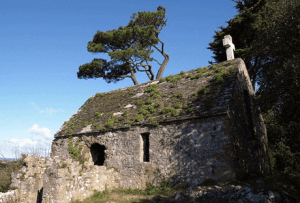
For the first time in decades it’s possible to glimpse the medieval St Michael’s Chapel. It’s along the side of Newton Road, opposite Torre Station, right at the summit of the sheer side of Chapel Hill.
It’s probably 13th or 14th century and is made from local grey limestone rubble with some red sandstone dressings. The stone pointed-barrel vaulted slate roof supports a flora including daisies and is unusual for our region. Not of any great age was the cross – recently removed – which was erected by order of the Marchioness of Bute early in the 19h century.
It has a small aisleless chapel, and a slit window on the south side, along with a segmental-headed arched doorway with red sandstone voussoirs and the stub walls of a former porch. The east end has an unglazed segmental-headed window opening. The west end wall is thicker towards the bottom with a slit window in the gable end wall. Oddly, the floor is uneven bedrock, and it falls away from east to west. No attempt has been made to cut away or level the rock.
While most historians assume that the chapel belonged to Torre Abbey, it’s a bit strange that episcopal registers and cartularies don’t record its existence.
Over the years it has been described as a sea mark, the abode of a hermit, a place of retreat, of punishment, or a votive chapel built by mariners who had escaped ship wreck. What we do know is that there aren’t tunnels to the abbey or anywhere else as was once rumoured.
It was said that a light was hung there as a signal to those at sea. Supporting the idea that it was some early form of lighthouse is that the hill was once tree-less and visible from the Bay. The Reverend John Swete on his historic tour in 1783 drew the chapel as being on a barren hillside. On the other hand, Chapel Hill is a long way inland, and the cliffs at Rock Walk may have made a more visible position for sailors.
The chapel was certainly significant for seafarers. A guidebook of 1793 reports that, “The Tor Chapel, perched on the summit of the ridge of rocks, once an appendage of the abbey before us and as it has not been desecrated it is sometimes visited by Roman Catholic crews of the ships lying in the bay.”
From an 1850 book Legends of Torquay comes an old story of a mariner who, having been shipwrecked, built the chapel and lived there as hermit, forever watching the place where his ship sank. Some 300 years later his ghost helped the save the life of the fiancé of a Torquay girl called Rosalind.
However, there’s even some debate over whether the chapel should even be called St Michael’s. St Michael is a saint of high places, and there are several other St Michaels built on steep hills such as Brent Tor and in Cornwall and Normandy.
Yet, an artist in 1662 called it St Marie’s Chapel, as did John Speed in an old map in 1616. In a deed of 1238 there’s a reference to a hill called la Windiete. One suggestion is that Roger de Cockington built and dedicated the chapel to his wife Maria.
Another possibility is that, while the chapel may have originally been known as St Marie’s, it was built on an older place of pre-Christian significance. It was common to build churches on former pagan sites and the Archangel Michael was the field commander of the Army of God in the Books of Daniel, Jude and Revelation. St Michael led God’s armies against Satan’s forces during his uprising, and so, it’s been suggested, that Torre’s early Christians acquired the site for their new religion. It was named to establish a victory over evil, with the chapel – whatever its true name – coming later.
Indeed, across the valley and the Teignmouth Road is Daison Rock. Intriguingly, the word Daison seems to derive from the Old English daegsan meaning ‘a sacrificial stone’.



























